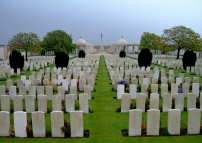| First Name: | William George | Last Name: | HOBBS | |
|---|---|---|---|---|
| Date of Death: | 25/09/1915 | Lived/Born In: | Kew | |
| Rank: | Lieutenant | Unit: | Royal Berkshire8 | |
| Memorial Site: | 1. Richmond-on-Thames Memorial 2. Loos Memorial, France | |||
Current Information:Age-24
122, Mortlake Road, Kew Gardens
The Battle of Loos, fought by the British Army from 25th September, 1915 through to 13th October, was conducted along a six-and-a-half-mile front running north from the mining village of Loos on the outskirts of Lens in Northern France. It was the largest offensive carried out by the British so far in the war. The opening day involved an attack by six divisions, with others entering the fray as it progressed and it was part of a much wider offensive with the French launching their own attacks in Champagne and at Vimy. It was the first time that the British used gas during the war, despite their condemnation of the Germans for doing the same in April 1915. There were some encouraging results on the first day but no major breakthrough was achieved and in the successive days the offensive became mired in trench warfare. By mid-October the battle had petered out with the British having suffered over 60,000 casualties during its course. 1st Division attacked along 1400 yards of front from a point opposite the Loos Road Redoubt to the Vermelles-Hulluch road. Jumping off trenches had been dug 300 yards in front of British line but the German trenches were still 300-400 yards off and on the other side of the crest of the Grenay ridge. To gain visibility, the Germans had run out saps and manned them with machine guns. At 5.50am on 25th September, 1915, a heavy British bombardment commenced and the gas cloud of chlorine was released. 1 Brigade attacked due east with the southern part of Hulluch as their objective. The attack was led by 10th Gloucestershire and 8th Royal Berkshire, two New Army battalions that had replaced the Guards battalions in 1 Brigade. The were affected by gas from leaky cylinders, but not so badly as in other places along the line of attack and the advance continued with 50 paces between ranks. Two small copses on the crest of the ridge confronted them. Bois Carré in front of 10th Gloucestershire and La Haie in front of 8th Royal Berkshire These had been reduced to shattered scrub and offered no real obstacle except that the Germans had extended saps to them and placed machine guns there and the inevitable casualties ensued. 10th Gloucestershire suffered heavily but overran Bois Carre and took the German front line where they were held up by heavy machine gun fire from German support line 80 yards further back. They attacked across the open which resulted in many more casualties among their ranks but the Germans retreated along communication trenches towards Hulluch. There were only 60 survivors of 10th Gloucestershire left to continue the attack. 8th Royal Berkshire took La Haie and the German front line with most of their casualties occuring when dealing with the partially cut wire. By 8am, after a further successful advance 8th Royal Berkshire reached the southern end of Gun Trench, 500 yards from the Lens road. 1st Cameron Highlanders, in support, moved up and captured three field guns on their way to the road where they halted and sent out parties to reconnoitre Hulluch. They did not enter the village but reported the Germans to be retiring. A mixed force of 8th Royal Berkshire, 10th Gloucestershire and 1st Cameron Highlanders faced Hulluch waiting for reinforcements to arrive. |
||||
| « Back to Search Results | ||||
| If you think any of the information shown here is incorrect, Click Here to submit your amends and comments | ||||




